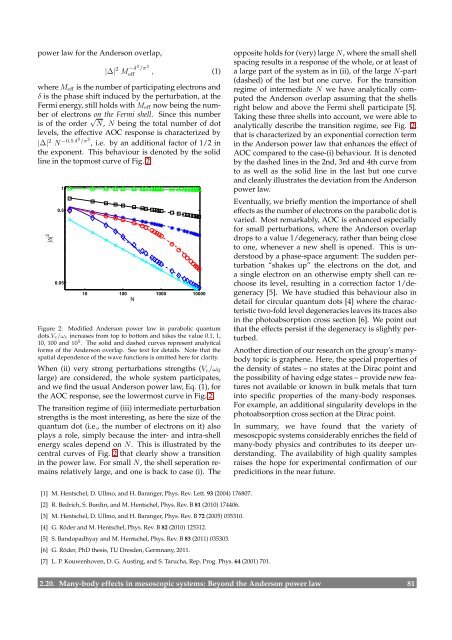Contents - Max-Planck-Institut für Physik komplexer Systeme
Contents - Max-Planck-Institut für Physik komplexer Systeme
Contents - Max-Planck-Institut für Physik komplexer Systeme
Create successful ePaper yourself
Turn your PDF publications into a flip-book with our unique Google optimized e-Paper software.
power law for the Anderson overlap,<br />
|∆| 2 M −δ2 /π 2<br />
eff , (1)<br />
where Meff is the number of participating electrons and<br />
δ is the phase shift induced by the perturbation, at the<br />
Fermi energy, still holds with Meff now being the number<br />
of electrons on the Fermi shell. Since this number<br />
is of the order √ N, N being the total number of dot<br />
levels, the effective AOC response is characterized by<br />
|∆| 2 N −0.5 δ2 /π 2<br />
, i.e. by an additional factor of 1/2 in<br />
the exponent. This behaviour is denoted by the solid<br />
line in the topmost curve of Fig. 2.<br />
|∆| 2<br />
1<br />
0.5<br />
0.05<br />
10 100 1000 10000<br />
N<br />
Figure 2: Modified Anderson power law in parabolic quantum<br />
dots.Vc/ωc increases from top to bottom and takes the value 0.1, 1,<br />
10, 100 and 10 5 . The solid and dashed curves represent analyitcal<br />
forms of the Anderson overlap. See text for details. Note that the<br />
spatial dependence of the wave functions is omitted here for clarity.<br />
When (ii) very strong perturbations strengths (Vc/ω0<br />
large) are considered, the whole system participates,<br />
and we find the usual Anderson power law, Eq. (1), for<br />
the AOC response, see the lowermost curve in Fig. 2.<br />
The transition regime of (iii) intermediate perturbation<br />
strengths is the most interesting, as here the size of the<br />
quantum dot (i.e., the number of electrons on it) also<br />
plays a role, simply because the inter- and intra-shell<br />
energy scales depend on N. This is illustrated by the<br />
central curves of Fig. 2 that clearly show a transition<br />
in the power law. For small N, the shell seperation remains<br />
relatively large, and one is back to case (i). The<br />
[1] M. Hentschel, D. Ullmo, and H. Baranger, Phys. Rev. Lett. 93 (2004) 176807.<br />
[2] R. Bedrich, S. Burdin, and M. Hentschel, Phys. Rev. B 81 (2010) 174406.<br />
[3] M. Hentschel, D. Ullmo, and H. Baranger, Phys. Rev. B 72 (2005) 035310.<br />
[4] G. Röder and M. Hentschel, Phys. Rev. B 82 (2010) 125312.<br />
[5] S. Bandopadhyay and M. Hentschel, Phys. Rev. B 83 (2011) 035303.<br />
[6] G. Röder, PhD thesis, TU Dresden, Germnany, 2011.<br />
[7] L. P. Kouwenhoven, D. G. Austing, and S. Tarucha, Rep. Prog. Phys. 64 (2001) 701.<br />
opposite holds for (very) large N, where the small shell<br />
spacing results in a response of the whole, or at least of<br />
a large part of the system as in (ii), of the large N-part<br />
(dashed) of the last but one curve. For the transition<br />
regime of intermediate N we have analytically computed<br />
the Anderson overlap assuming that the shells<br />
right below and above the Fermi shell participate [5].<br />
Taking these three shells into account, we were able to<br />
analytically describe the transition regime, see Fig. 2,<br />
that is characterized by an exponential correction term<br />
in the Anderson power law that enhances the effect of<br />
AOC compared to the case-(i) behaviour. It is denoted<br />
by the dashed lines in the 2nd, 3rd and 4th curve from<br />
to as well as the solid line in the last but one curve<br />
and cleanly illustrates the deviation from the Anderson<br />
power law.<br />
Eventually, we briefly mention the importance of shell<br />
effects as the number of electrons on the parabolic dot is<br />
varied. Most remarkably, AOC is enhanced especially<br />
for small perturbations, where the Anderson overlap<br />
drops to a value 1/degeneracy, rather than being close<br />
to one, whenever a new shell is opened. This is understood<br />
by a phase-space argument: The sudden perturbation<br />
“shakes up” the electrons on the dot, and<br />
a single electron on an otherwise empty shell can rechoose<br />
its level, resulting in a correction factor 1/degeneracy<br />
[5]. We have studied this behaviour also in<br />
detail for circular quantum dots [4] where the characteristic<br />
two-fold level degeneracies leaves its traces also<br />
in the photoabsorption cross section [6]. We point out<br />
that the effects persist if the degeneracy is slightly perturbed.<br />
Another direction of our research on the group’s manybody<br />
topic is graphene. Here, the special properties of<br />
the density of states – no states at the Dirac point and<br />
the possibility of having edge states – provide new features<br />
not available or known in bulk metals that turn<br />
into specific properties of the many-body responses.<br />
For example, an additional singularity develops in the<br />
photoabsorption cross section at the Dirac point.<br />
In summary, we have found that the variety of<br />
mesoscpopic systems considerably enriches the field of<br />
many-body physics and contributes to its deeper understanding.<br />
The availability of high quality samples<br />
raises the hope for experimental confirmation of our<br />
predicitions in the near future.<br />
2.20. Many-body effects in mesoscopic systems: Beyond the Anderson power law 81
















